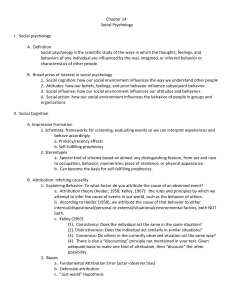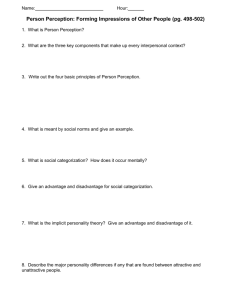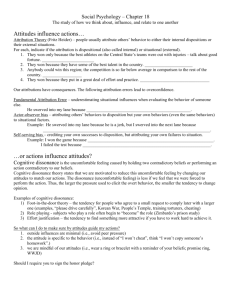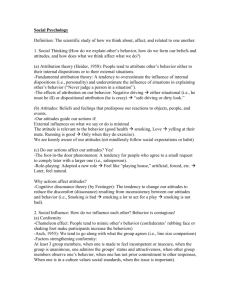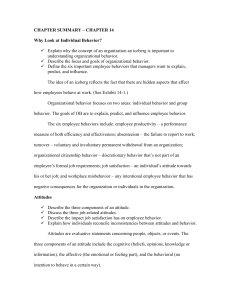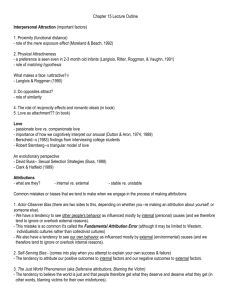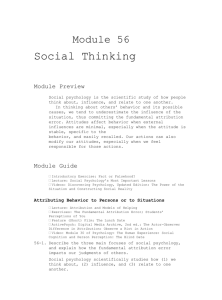Psychology Final Social Psychology Attribution (724
advertisement
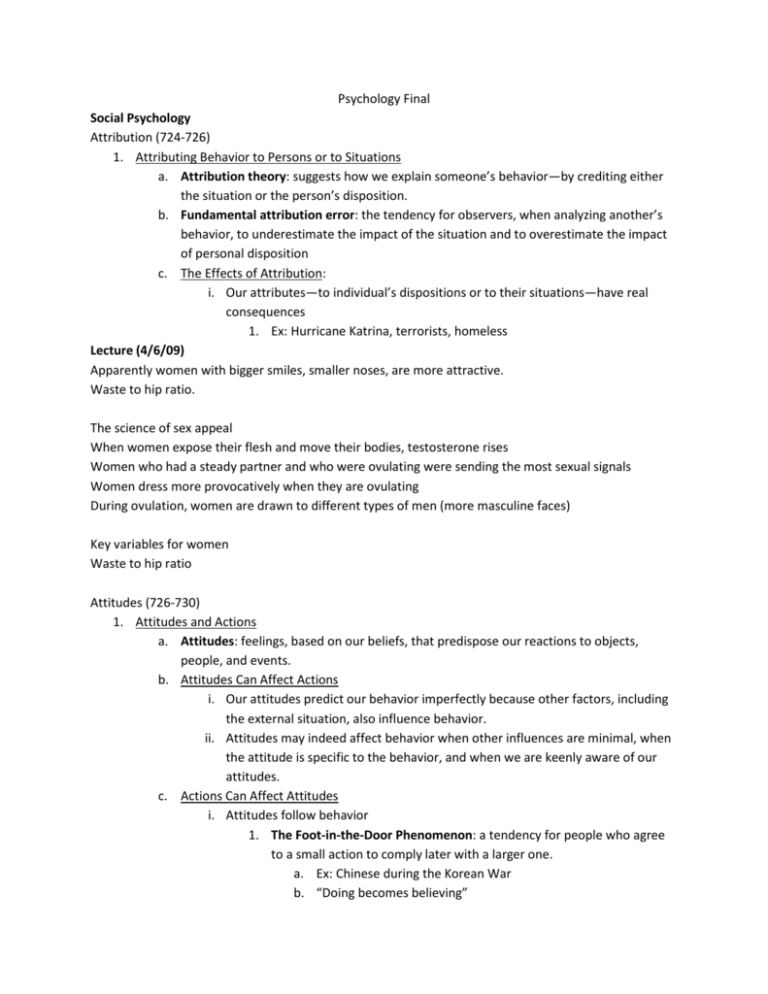
Psychology Final Social Psychology Attribution (724-726) 1. Attributing Behavior to Persons or to Situations a. Attribution theory: suggests how we explain someone’s behavior—by crediting either the situation or the person’s disposition. b. Fundamental attribution error: the tendency for observers, when analyzing another’s behavior, to underestimate the impact of the situation and to overestimate the impact of personal disposition c. The Effects of Attribution: i. Our attributes—to individual’s dispositions or to their situations—have real consequences 1. Ex: Hurricane Katrina, terrorists, homeless Lecture (4/6/09) Apparently women with bigger smiles, smaller noses, are more attractive. Waste to hip ratio. The science of sex appeal When women expose their flesh and move their bodies, testosterone rises Women who had a steady partner and who were ovulating were sending the most sexual signals Women dress more provocatively when they are ovulating During ovulation, women are drawn to different types of men (more masculine faces) Key variables for women Waste to hip ratio Attitudes (726-730) 1. Attitudes and Actions a. Attitudes: feelings, based on our beliefs, that predispose our reactions to objects, people, and events. b. Attitudes Can Affect Actions i. Our attitudes predict our behavior imperfectly because other factors, including the external situation, also influence behavior. ii. Attitudes may indeed affect behavior when other influences are minimal, when the attitude is specific to the behavior, and when we are keenly aware of our attitudes. c. Actions Can Affect Attitudes i. Attitudes follow behavior 1. The Foot-in-the-Door Phenomenon: a tendency for people who agree to a small action to comply later with a larger one. a. Ex: Chinese during the Korean War b. “Doing becomes believing” 2. Role Playing Affects Attitudes: Following the social prescriptions of a stereotype/role (college student, nurse, etc) a. The psychologist’s fake jail b. What we do, we gradually become 3. Cognitive Dissonance: Relief from Tension: We often bring our attitudes into line with our actions. a. We become aware that our attitudes and actions don’t coincide; we experience tension, or cognitive dissonance. b. Ex: War in Iraq 4. Although we cannot directly control all our feelings, we can influence them by altering our behavior. Lecture (4/8/09) The more faces you put together, the better the composite reaches the statistical average of the species. “Averaging of faces” Symmetry: more symmetrical=more attractive Study done: Some Characteristics Preferred by Males: Kindness and Understanding, Intelligence, Physical Attractiveness, Exciting Personality, Good Health, Adaptability, etc. Some Characteristics Preferred by Females: Kindness and understanding, intelligence, exciting personality, good health, adaptability, physical attractiveness, creativity, etc. Men are interested in looks much more than women are Washington and Lincoln were most popular presidents and they were the tallest compared to the average population Attractive women tend to make more money Taller men tend to make more money Lecture (4/13/09) When women are ovulating they prefer a more masculine face Attitudes: Attitude: tendency to response positively or negatively toward a certain person, object, idea, or situation. Three components of an attitude are the affective (emotional) component, the behavioral component, and the cognitive component (what you think). Attitudes are poor predictors of behavior Formation of Attitudes Direct contact with the person, situation, object, or idea Direct instruction from parents or others Interacting with other people who hold a certain attitude (Burns study) Watching the actions and reactions of other to ideas, people, objects, and situations Persuasion (Attitude Change) The process by which one person tries to change the belief, opinion, position, or course of action of another person through argument, pleading, or explanation o Key elements are the source of the message, the message itself, and the target audience o Prettier more popular people influence more o Persuaded more with emotional messages (fear) Elaboration likelihood model: Model of persuasion stating that people will either elaborate on the persuasive message or fail to elaborate on it, and that the future actions of those who do elaborate are more predictable than those who do not o Central-route processing: type of information processing that involves attending to the content of the message itself. (When you have a really strong argument) o Peripheral-route processing: type of information processing that involves attending to factors not involved in the message, such as the appearance of the source of the message, to the length of the message, and other non-content factors Cognitive Dissonance: Sense of discomfort or distress that occurs when a person’s behavior Lecture (4/15/09) Cognitive Dissonance: sense of discomfort or distress that occurs when a person’s behavior does not correspond to that person’s impression formation the forming of the fist knowledge that a person has concerning another person Study done on paid experiments with lying. Two studies gave out $1 and $20. $1 group rated the experiment as more interesting. $20 group justified lying because it was a large sum of money. Lessened by changing the conflicting behavior, changing the conflicting attitude, or forming a new attitude to justify the behavior Prejudice and Discrimination Prejudice: Negative attitude held by a person about the members of a particular social group Discrimination: Treating people differently because of prejudice toward the social group to which they belong Forms of prejudice include ageism, sexism, racism, and prejudice toward those who are too fat or too thin. Stereotype: a generalized (sometimes accurate, but often over generalized) belief about a group of people. Lecture (4/20/09) Psych of Aggression 1. dealing with aversive events 2. learning that aggression is rewarding 3. observing environment 4. acquiring social scrips Aversive events – studies in which animals and humans experience unpleasant events reveal that those made miserable often make others miserable Environment – even environmental temperature can lead to aggressive acts. Murders and rapes increased with temperature in Houston Learning Aggression is Rewarding when aggression lead to desired outcomes one learns to be aggressive. This is shown in both animals and humans cultures that favor violence breed violence. Scotch-Irish settlers in the South had more violent tendencies than their Quaker Dutch counterparts in the NE of US Acquiring Social Scripts - media portrays social scripts and generates mental tapes in the minds of the viewers. When confronted with new situations individuals may rely on such social scripts. If social scripts are violent in nature, people may act them out Ex. Jerry Springer Do Video Games teach or release violence? * general consensus on violent video games is that to some extent they breed violence especially impressionable upon young children. Adolescents view the world as hostile when they get into arguments and receive bad grades after playing such games- stronger affects than any other media Lecture (4/22/09) Altruism: Pro-social behavior that is done with no expectations of reward and may involve the risk of harm to oneself Pro-social Behavior: socially desirable behavior that benefits others. Bystander Effect: referring to the effect that the presence of other people has on the decision to help or not help, with help becoming less likely as the number of bystanders increases Diffusion of responsibility: occurring when a person fails to take responsibility for actions or for inaction because of the presence of other people who are seen to share the responsibility Researched Latane and Darley found that people who were alone were more likely to help in an emergency than people who were with others o One bystander cannot diffuse responsibility 5 Steps in Making a Decision to Help 1. Noticing 2. Defining an emergency 3. Taking responsibility 4. Planning a course of action 5. Taking action Lecture (4/24/09) Nocrum designed experiment? Watched a video on a psych experiment Teacher gives the other experimenter a shock Ex: Putting Lecture (4/27/09) Social Influence- the process through which the real or implied presence of others can directly or indirectly influence the thoughts, feelings, and behavior of an individual Conformity- changing one’s own behavior to match that of other people (ex: clothes) Compliance- changing one’s behavior as a result of other people directing or asking for the change Obedience- altering behavior in response to a direct order (authority figure). Milgrum study (video) Asch’s Study of Conformity Shows 1 line then shows a series of 3 other lines (varying in length)… and then asks which one is equivalent in length to the first line? There were complaints who would state the wrong answer consistently and others would conform. Reasons for conformity: Normative Social Influence: influence resulting from a person’s desire to gain approval or avoid rejection Informative Social Influence: influence resulting from a person’s desire to be correct. Factors that Strengthen Conformity 1. One is made to feel incompetent or insecure 2. The group has at least three people 3. The group is unanimous 4. One admires the group’s status and attractiveness Four ways to Gain Compliance 1. Foot in the Door technique: asking for a small commitment and, after gaining compliance, asking for a bigger commitment 2. Door in the face technique: asking for a large commitment and being refused, and then asking for a smaller commitment Norm of reciprocity: assumption that if someone does something for a person, that person should do something for the other in return 3. Lowball technique- getting a commitment from a person and then raising the cost of that commitment 4. That’s not all technique- a sales technique in which the persuader makes an offer and then adds something extra to make the offer look better before the target person can make a decision Lecture (4/29/09) Milgrum Study: revolutionized behavioral psychology Less than 1% of psychologists thought the person would go all the way through to the top volts Study suggests everyone is capable of doing horrible things “You are just hours away from doing things you never thought you would do” Changed the way we do research Consent forms are direct result of Milgrum study Deception in the study: o Voice recording (patients screaming) o They were told they had an equal chance of being the teacher/learner o The learner was an actor o Told them the study was about “learning” but in fact it was really about how people “obey authority” Social Thinking 1. Does his absenteeism signify illness, laziness, or a stressful work atmosphere? 2. Was the horror of 9/11 the work of crazed evil people or ordinary people corrupted by life events. Social thinking involves thinking about others, especially when they engage in doing things that are unexpected Attributing Behavior to Persons or to Situations Attribution Theory: Fritz Heider (1958) suggested that we have a tendency to give casual explanations for someone’s behavior, often by crediting either the situation or the disposition A teacher may wonder whether a child’s hostility reflects an aggressive personality (dispositional attribution) or is a reaction to stress or abuse (a situational attribution) Person vs. Situation Attributions Have to decide whether behavior is due to something about personality, or whether anyone would do same thing in that situation Kelley’s 3 questions in making an attribution o Does this person regularly behave this way in this situation? o Do others regularly behave this way in this situation? o Does this person behave this way in many other situations? o Example: Susan is angry while driving in a traffic jam Is it because Susan Is an angry person? Does Susan Regularly Do many other Does Susan get get angry in traffic people get angry in angry in many other jams? traffic jams? situations? No personality or situational attribution Situational attribution: traffic jams make people mad Personality attribution, general Personality attribution, particular Fundamental Attribution Error Tendency to overestimate the impact of personal disposition and underestimate the impact of the situations in analyzing the behaviors of others leads to the fundamental attribution error. We see Joe as quiet, shy, and introverted most of the time, but with friends he is very talkative, loud, and extroverted. Cross-Cultural differences Western culture: People are in charge of own destinies, more attributions to personality Eastern culture: fate in charge of destiny, more attributions to situation. Actor-Observer Discrepancy Attribute personality causes of behavior when evaluation someone else’s behavior Attribute situational when evaluation our own behavior Why? Hypothesis 1: We know our behavior changes from situation to situation, but we don’t know this about others Hypothesis 2: When we see others perform an action, we concentrate on actor, not situation— when we perform an action, we see environment, not person. Self Serving Bias We tend to make internal attributions for our success and external for our failure Lecture (5/1/09) Group Influence How do groups affect our behavior? Social psychologists study various groups: 1. One person affecting another 2. Families 3. Teams 4. Committees Social Loafing The tendency of an individual in a group to exert less effort toward attaining a common goal than when tested individually (Latane, 1981) Deindividuation The loss of self-awareness and self-restraint in group situations that foster arousal and anonymity (Mob behavior, costume parties) Effects of Group Interaction Group Polarization: enhances a group’s prevailing attitudes through a discussion. If a group is likeminded, discussion strengthens its prevailing opinions and attitudes. Groupthink A mode of thinking that occurs when the desire for harmony in a decision-making group overrides the realistic appraisal of alternatives Attack on Pearl Harbor Kennedy and the Bay of Pigs Watergate Cover-up Chernobyl Reactor Accident

